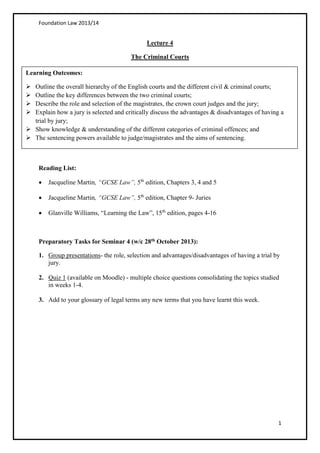
Lecture 4 handout
- 1. Foundation Law 2013/14 1 Lecture 4 The Criminal Courts Reading List: Jacqueline Martin, “GCSE Law”, 5th edition, Chapters 3, 4 and 5 Jacqueline Martin, “GCSE Law”, 5th edition, Chapter 9- Juries Glanville Williams, “Learning the Law”, 15th edition, pages 4-16 Preparatory Tasks for Seminar 4 (w/c 28th October 2013): 1. Group presentations- the role, selection and advantages/disadvantages of having a trial by jury. 2. Quiz 1 (available on Moodle) - multiple choice questions consolidating the topics studied in weeks 1-4. 3. Add to your glossary of legal terms any new terms that you have learnt this week. Learning Outcomes: Outline the overall hierarchy of the English courts and the different civil & criminal courts; Outline the key differences between the two criminal courts; Describe the role and selection of the magistrates, the crown court judges and the jury; Explain how a jury is selected and critically discuss the advantages & disadvantages of having a trial by jury; Show knowledge & understanding of the different categories of criminal offences; and The sentencing powers available to judge/magistrates and the aims of sentencing.